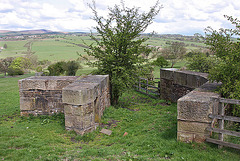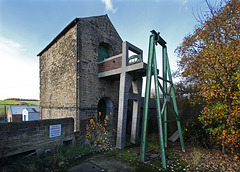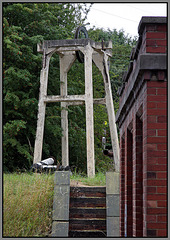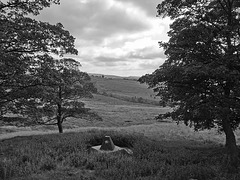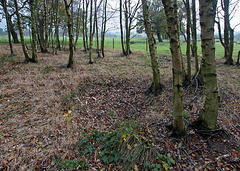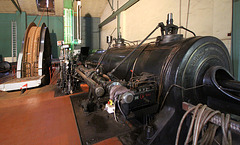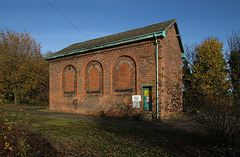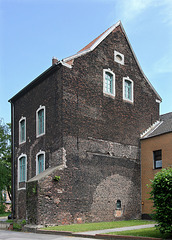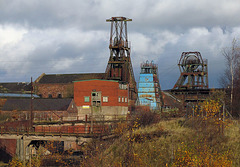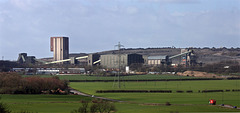
Coal Mining
Astley Green sunset
Turning pillars
| |
|
Habergham Colliery was sunk by The Exors of John Hargreaves in 1868-70 and distributed its coal by cart until around 1900 when a chain ginney line was built to connect at Cornfield Colliery with the ginney to Padiham. This line incorporated a tunnel under Tipping Hill Plantation and a turning point at about half way. The colliery operated until 1941 when a shortage of labour cause Hargreaves Collieries to close the pit and transfer the men to their other workings.
Turning the direction of tubs on a chain hauled line was quite a complicated business involving the detaching of the tubs from the haulage chain before the change of direction and their reattachment afterwards. The operation was supposed to be automatic but there are many tales of problems which often necessitated a man being placed at the turn to supervise the operation. This image shows the remains of the turning pillars above Cornfield Farm. The substantial construction reflects the heavy loads and hard use to which it was put.
Chatterley Whitfield
| |
|
|
The carcase of Chatterley Whitfield Colliery continues to rot away. Shame on you Stoke Council.
Westfield pumping pit
| |
|
The Westfield Pit was sunk in 1820 and the Newcomen pumping engine was set to work in 1823 to pump water for nearby Newbiggin Colliery. The shaft still forms a part of the Harworth pumping regime with electric pumps in place.
Old workings
Thornsett Hey Sough
| |
|
|
Colliery soughs are well worth seeking out and this example probably dates from the early nineteenth century. Originally used as a drainage and tramming level with a tramroad to take the coal down to a yard by the nearby road. It served to drain, amongst others, Thornsett Hey Colliery and the splendidly named Cave Abdullam Pit, and the abandonment plans suggest that mining ceased here in 1886. The trademark ochreous silt that usually marks old coal workings is present in large quantities here along this stone arched section which comprises the first 167 yards of the 649 yard tunnel. Plenty of water still issues from the sough.
Valve gear
| |
|
Valve gear on the ground floor of the Elsecar pumping engine. This is the only Newcomen engine that survives in its original enginehouse.
Pumping shaft
| |
|
This small concrete headframe stands over a pumping shaft adjacent to the Elsecar pumping enginehouse.
Bakestonedale Collieries
| |
|
|
Bakestonedale Moor above Pott Shrigley has seen an extensive coal mining industry over the past 2-300 years. The last coal and fireclay extraction took place in the mid 1960's before the Peak Park planners put a stop to it. The nineteenth century workings left a number of deep shafts which remained open until the 1970's when they were capped by the then National Coal Board leaving distinctive concrete obelisks on the shaft top.
Wren's Nest Pit
| |
|
|
In 1826 the working of the Gees seam at Poynton Colliery was being pursued at a number of shafts to the east of where the Macclesfield Canal would be built a few years later. At that time an engine pit was being sunk immediately east of Elmbeds Farm and the Wren's Nest shaft was to become the Bye Pit to it. The depth of the shaft was about 66 yards. Both pits were connected by a tramroad which ran downhill to the Smithfield Pits on Coppice Road. They were abandoned in the 1840s and today all that remains of these pits are the slight depressions where the shafts lie, and a small scatter of spoil.
Daw Mill in happier times
| |
|
|
Daw Mill, which was Britains most productive colliery in recent years, is now shut down and abandoned after a major underground fire. This view was made few years ago when it seemed to have a fairly decent future.
Bergwerk Saar, Ensdorf
| |
|
Right up to closure in June 1912 this winding engine by Dinglersche Maschinenfabrik A.G. in 1918 was used to wind materials in one of the shafts. Coal production by this time was brought up a drift.
Car House Colliery, Rotherham
| |
|
|
The pumping enginehouse at Car House Colliery in Rotherham once contained steam plant, but now houses electric equipment. After closure of the colliery the shaft was retained for pumping to protect the workings at Maltby Colliery. Now that Maltby has closed the future of this building must be in doubt.
Eschweiler pump
| |
|
In 1784 Johann Peter Wültgens extended the coal concessions he had in the area of Eschweiler near Aachen. In 1794 a Newcomen type pumping engine was erected on the colliery which is described as driving 2 pumps with 42m of rods. It worked at 11-12 1.76m strokes per minute. It was one of the earliest steam engines in Germany. The enginehouse survives and is rather different from the normal British practice where the beam pivoted on an outer wall and the shaft was outside the building. In this case it looks as if the engine was entirely within the building.
Chatterley Whitfield Colliery
| |
|
Sheaves on the Winstanley shaft at Chatterley Whitfield Colliery through the remains of the dirt tip conveyor system.
Mendip Colliery
| |
|
The Somerset coalfield was a fascinating place for rural and old-fashioned looking collieries. Mendip Colliery was developed after the old capped shaft at Strap Pit was reopened and drained in 1954-56 in an attempt to prove resources in the area. Subsequently it was developed as a winding shaft connected to the workings at New Rock in order to increase potential output to 70-90,000 tons per annum. New Rock winding shaft was 1,182 ft deep but only 4ft 6in diameter which severely limited daily output. This view by the late Ron Dyer shows the pit with the temporary winding enginehouse and headgear used whilst cleaning out the old shaft which turned out to be10ft 6in diameter rather than the 15ft expected. All the investment in developing the colliery was of little benefit as New Rock began to lose money due to technical difficulties of working the faces with coal ploughs and the need to transport coal away by road. New Rock closed on 28 September 1968 and salvaging the pit followed quickly. By June 1969 the shafts had been filled.
Three headframes
| |
|
Three of the four headframes at Chatterley Whitfield Colliery are lit up briefly by the winter sun. Sadly the future of the site is far less bright as this scheduled monument is left to decay.
Maltby Colliery in happier times
| |
|
Maltby Colliery commenced sinking in 1907 with production starting in 1911. The mine had a difficult time in the past few years and in February 2007 was sold to Hargreaves Services by UK Coal plc. With a workforce of around 500 it was producing c800,000 tonnes of coal a year of which more than 60% went to Drax power station. The colliery also supplied coking coal to the Monckton coking plant. Finally defeated by geological difficulties the pit has now closed and is being stripped.
Jump to top
RSS feed- Latest items - Subscribe to the latest items added to this album
- ipernity © 2007-2024
- Help & Contact
|
Club news
|
About ipernity
|
History |
ipernity Club & Prices |
Guide of good conduct
Donate | Group guidelines | Privacy policy | Terms of use | Statutes | In memoria -
Facebook
Twitter


